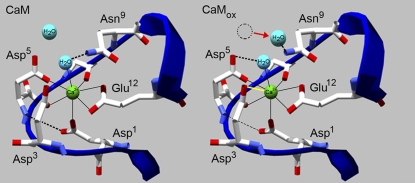FIGURE 5.
Oxidation-induced destabilization of helices in EF-hand by oxidized methionine (not shown) results in altered conformation of EF-loop that affects Ca2+ liganding. Alterations in Ca2+ liganding involve modifications in hydrogen bonding (dashed lines) and repositioning of a water molecule (red arrow) that displaces hydrogen-bonding interaction between Asn9 and the chelating water ligand. Changes in binding involve diminished hydrogen bonding between Asp1 and the backbone (CaMox, thin dashed line), apparent as an upshift in monodentate Asy COO− absorbance from 1593(−) cm−1 to 1602(+) cm−1 (Fig. 4 B), which may result from destabilization of the EF-loop (not shown). This also permits the formation of a bidentate ligation of Ca2+ by Asp3 (CaMox, yellow line), and a pseudobridging interaction between the available noncoordinating oxygen atom of Asp5 (CaMox, thick dashed line), apparent as a downshift from 1580(−) cm−1 to 1549(+) cm−1 and 1580(−) cm−1 to 1570(+) cm−1, respectively (Fig. 4 B). Model depicts Ca2+ binding site IV (1exr.pdb) (59), with generic numbering of Ca2+ ligands (Fig. 1) before (CaM) and after (CaMox) Met oxidation.

